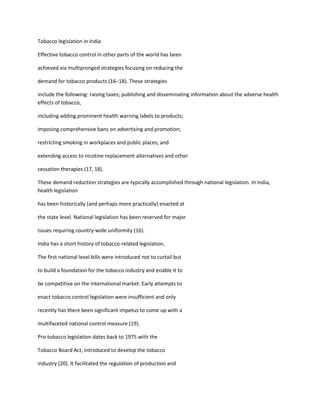
Tobacco legislation in india
- 1. Tobacco legislation in India Effective tobacco control in other parts of the world has been achieved via multipronged strategies focusing on reducing the demand for tobacco products (16–18). These strategies include the following: raising taxes; publishing and disseminating information about the adverse health effects of tobacco, including adding prominent health warning labels to products; imposing comprehensive bans on advertising and promotion; restricting smoking in workplaces and public places; and extending access to nicotine replacement alternatives and other cessation therapies (17, 18). These demand reduction strategies are typically accomplished through national legislation. In India, health legislation has been historically (and perhaps more practically) enacted at the state level. National legislation has been reserved for major issues requiring country-wide uniformity (16). India has a short history of tobacco-related legislation. The first national level bills were introduced not to curtail but to build a foundation for the tobacco industry and enable it to be competitive on the international market. Early attempts to enact tobacco control legislation were insufficient and only recently has there been significant impetus to come up with a multifaceted national control measure (19). Pro-tobacco legislation dates back to 1975 with the Tobacco Board Act, introduced to develop the tobacco industry (20). It facilitated the regulation of production and
- 2. curing of tobacco, fixed minimum prices, and provided subsidies to tobacco growers; the objective was to develop the Indian tobacco market and make the industry export competitive (21). Similarly, the Tobacco Cess Act of 1975 was enacted to collect duty on tobacco for the development of the tobacco industry (21). Anti-tobacco advocates have criticized these Acts because they nurtured the tobacco industry through subsidies and loose export policies (21, 22). India’s first national level anti-tobacco legislation was the single-faceted Cigarettes Act of 1975, which mandated health warnings on cigarette packets and on cigarette advertisements (23). This Act prescribed all packages to carry the warning ‘‘Cigarette smoking is injurious to health’’ in the same language used in the branding on the package. The text was to be a minimum of 3 mm in height, irrespective of the dimensions of the surface on which it appeared or of the dimensions of the brand name (21). While this Act was a major step in tobacco control, it did not apply to non-cigarette tobacco products. In the years following the Cigarettes Act of 1975, there were a number of other single-faceted national attempts at controlling tobacco use. For instance, in statutes dealing with the preservation of the environment, the Prevention and Control of Pollution Act of 1981 included smoking in the definition of air pollution (23). The Motor Vehicles Act of 1988 made it illegal to smoke or spit in a public vehicle (23). Finally, the Cable Television Networks Amendment Act of 2000
- 3. prohibited the transmission of tobacco, liquor, and baby food commercials on cable television across the country (24). Many state-level governments in India have imposed different types of tobacco control legislation. The Delhi government was the first to impose a ban on smoking in public places, with the Delhi Prohibition of Smoking and Nonsmokers Health Protection Act of 1996 (25). In addition to prohibiting the sale of cigarettes to minors and prohibiting sale 100 m from a school building, this law allowed for enforcement in public places and public transport by the police and medical professionals. A first time offender is fined 100 rupees (US$ 2.40) and briefed by the police or medical officer about the law and the negative health consequences of tobacco use. As expected, it has been difficult to enforce this ambitious programme, and it has probably had little real impact — the key problem being lack of manpower to enforce the law (26, 27). Other states too have enacted bans on public smoking. For example, in 1999 the Kerala High Court came out with a judgement prohibiting smoking in public places, including parks and highways (27, 28). Similarly, the state of Goa introduced anti-tobacco legislation in 1999. Following intense lobby from pro-tobacco groups the final legislation was a diluted version of the original bill, but did maintain an important provision that banned smoking in public places (29). Spitting of residues from chewing tobacco in public places was also prohibited by the legislation. In the past 12 months, the states of Tamil Nadu and Andhra Pradesh have banned the
- 4. marketing and sales of guthka. In February 2001, Indian Prime Minister Vajpayee’s Union Cabinet introduced the Cigarettes and other Tobacco Products (Prohibition of Advertisement and Regulation of Trade and Commerce, Production, Supply and Distribution) Bill, a multifaceted anti-tobacco legislation to replace the Cigarettes Act of 1975 (30). Smoking in public places would be outlawed, the sale of tobacco to persons below 18 years of age would be prohibited, and tobacco packages would be required to have warnings the same size as that of the largest text in English or the local language. The proposed national Bill would prohibit tobacco companies from advertising and sponsoring sports and cultural events. Significantly, this Bill covers most tobacco products including not only cigarettes, but also cigars, bidis, cheroots, cigarette tobacco, pipe tobacco, hookah tobacco, chewing tobacco, pan masala, and guthka. The consequences of violating the laws under the Bill are far more stringent than with the original 1975 Act. Defying the ban by smoking in public places such as streets, parks or government complexes will be fined up to 200 rupees (US$ 4). The same fine applies to vendors who sell tobacco to minors (under-18-year-olds). A second-time offence will result in a fine of 100 000 rupees (US$ 2000) and imprisonment for up to 3 years (30).
